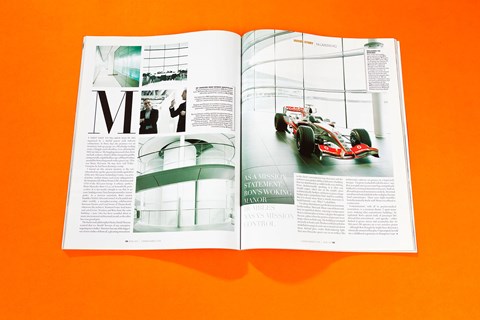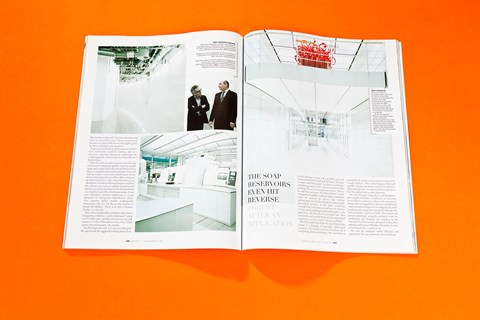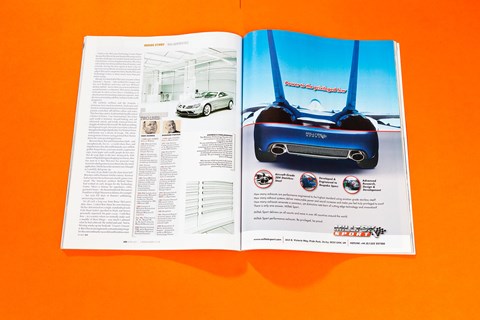My first visit to McLaren was 1967, organised by a dutiful parent with industry connections. In those days the premises was an insanitary lock-up garage on a Weybridge trading estate. A boggle-eyed schoolboy, I was admiring the M6 Can-Am car. My boggling increased when, from out back, a cheery, chattery bloke emerged in grubby racing overalls, unpolished lace-ups, rubbing Swarfega around his bitten fingernails with a greasy rag. That was Bruce McLaren. He may have said ‘G’day’. I imagine he had been draining a sump.
I mused on this ancient memory as the taxi whooshed me up the spectacular landscaped drive of the new McLaren Technology Centre, 124 acres of prime, verdant Surrey real estate subjugated to the titanium will of Ron Dennis CBE, chairman and CEO of the McLaren Group. A solitary, spotless, black Mercedes-Benz CL55 sat beneath the portecochère.
It is not nearly enough to say that in 40 years ‘trading estates’ have been promoted to ‘science parks’. As a mission statement, Ron’s manor humbles NASA’s Mission Control. It is beautiful and other worldly, a metaphor-testing collaboration between Dennis and Lord Foster of Thamesbank, otherwise the architect, Norman Foster. Soulmates and astral twins, Norman and Ron share the same birthday; 1 June. One has been awarded about as many international architectural awards as the other has won grand prix.
The backwoods philosopher Henry David Thoreau warned that we should ‘beware of any enterprise requiring new clothes’. Ron now has one of the biggest sets of new clothes of them all, a gleaming monument to the client’s uncompromising obsession and the architect’s near-perfect ability to deliver it. A building that was shortlisted at 4-1 odds for the 2005 Stirling Prize. Architecturally speaking, it is what you should expect when one of the world’s most technocratically bonkers architects is given a huge budget and a sympathetic brief. And it is startling.
But it is clearly more than is strictly necessary to build Formula 1 cars. ‘Why?’ I asked Ron. ‘I’ve always been keen to get the best environment for the workers,’ Ron said. About 1000 of them work here in sepulchral silence, enjoying a temperature that is constant plus or minus a degree throughout the year, a place where the positive air pressure never drops, where no birds sing. The building is arranged internally in boulevards. Workers in black uniforms modelled on surgical scrubs move noiselessly down them. Behind glass, under blink-inducing light, McLaren-Mercedes sports cars sit on trolleys like technocratic cadavers on gurneys in a hyper-tech morgue.
‘I’m pretty pissed-off with this mess,’ says Ron, as we pick our way over some bags surreptitiously hidden by a visiting Italian television crew. Staff are allowed no personal mementoes on desks. Ron tried a total ban on food and drink in the workplace because ‘food contaminates’. There were slight mumbles from the normally docile staff . Water was offered as a concession.

‘Contamination’, with all its psycho-medical associations, is a recurrent theme. ‘I spent many years studying what contaminates buildings,’ he explained. Ron’s special study of passenger lifts showed that conventional – and squeaky – cables bathed in grease attract and accumulate dirt. So McLaren’s lift operates on a vast, noiseless piston – although Ron thought he might have detected a minuscule amount of free play. Unprompted, he told me a childhood experience in Hampton Court Maze had been influential: ‘I had a fear of not knowing what was around the corner’. Hence, transparency becomes a weapon in the never-ending fight against the threat of hidden contamination.
Norman Foster thinks much the same way. Foster’s ideal architecture would be nothing, and as a necessary, reluctant, functional compromise he would regretfully settle on glazing. Those lift cars? Made of glass.
I lent on a wall to ponder a question, then fearing an imminent reprimand, quickly stood up straight again and worried about the smeared lenses of my glasses. I asked Ron where it all came from. ‘It started with my mother’s obsession with the home. It was always immaculate because of her efforts. You grow up with your parents’ values. You either move away 180 degrees, or embrace them and improve on them.’
Mrs Dennis may seem an unlikely inspiration for this bravura architectural marvel, but Norman Foster was similarly inspired by a homespun source. Foster uses redemptive modern architecture to escape memories of working-class Manchester’s clutter. Two centuries before another working-class Mancunian, Ann Lee, left the area for America to found The Shakers. ‘There is no dirt in heaven,’Mother Lee insisted ‘Dust’, Ron coincidentally assured me with a victor’s swaggering confidence, ‘can be eliminated.’ I asked wasn’t all this glass and tile in his heaven on earth expensive to clean? Ron did not miss a beat: ‘High capital, low maintenance,’ he averred.
Our PR chaperone said: ‘Let’s go to see the gym!’ We agreed and she suggested warning them of our arrival. Sensing a victim and a possible source of occult contamination, Ron said ‘No! Don’t.’ The gym is empty and immaculate, but Ron on predatory walkabout groaned: ‘This is the messiest part of the building.’ He saw some temporary notices. ‘Those,’ he said ‘have got to go.’ The PR scribbled. A wince of anguish crossed Ron’s unlined, lightly tanned face when he realised the physio had, without authorisation, move a device from its architecturally determined position. At this point something reminded me to mention my old boss Sir Terence Conran and his habit of going through people’s waste paper bins. ‘We don’t have waste paper bins,’ Ron countered, easily establishing a moral and practical superiority over the country’s design godfather.

But if the public face of the McLaren Technology Centre is a Xanadu of hard-edge architectural semantics, the bowels are more revealing still of compelling client psychologies. We went below in a goods lift. Its stainless steel cocoon was dented in a couple of places. ‘This is what happens,’ Ron said ruefully. ‘You get one bonk, you get two, then five. Then nobody cares.’ It seems you then cycle into a fast descending helix to utter depravity. We went through swing doors with kickplates. Ron regards kickplates as defeatist: an invitation for unreflective minions to abuse and contaminate fittings with steel-tipped boots. But his mood lightened when we found a ceiling cavity revealing the intestinal trunking and wiring that pump life through the McLaren body. ‘I just love M&E,’ Ron stared and purred admiringly, using the architect’s term for mechanical and electrical. An autoclave in the basement has been custom designed so that all its piping is orthogonal. Whether this makes it more or less functional, I could not say. We visit the computer room. ‘Humans and equipment! We can control the entire building!’
I believe the McLaren Technology Centre began because Ron Dennis became bored with racing success. Another challenge was needed, found and executed with absolute, unwavering determination. His critics said architecture distracted him from Formula 1 and, certainly, having the boss spend at least a day on site every two weeks for several years coincided with a dip in McLaren’s competitive form. But the McLaren Technology Centre is about much more than just motor racing.
Already, less than half of McLaren’s income is from Formula 1. Dennis – who worked for Cooper and has seen Brabham and Lotus and now Williams decline and fall – knows that you cannot indefinitely sustain Formula 1 as a business. McLaren is extending its brand. So what we have here is a building as an advertisement for daunting corporate expertise. And the most outstanding celebrity architect in the world designed it.
The celebrity architect and the Formula 1 aristocracy have much in common. Each exists and travels in an international caravan of air conditioned, particle-controlled, riff-raff free cabins and suites. They have bag-carriers. Each routinely handles unreal volumes of money. I say ‘international’, but in fact each world is hermetic, inward-looking and self-referential…utterly and totally removed from the struggles of ordinary life on earth. We shall say nothing of comparative egos, but each craves fame achieved through technological perfection. For Norman Foster architecture was a means of escape. The micro-management of motor racing pointed Ron Dennis down the same psychological route.
Between them, Ron and Norman have built – and, metaphorically, live in – a world where flaws and imperfections, dust, dirt and kickmarks, rust, rubbish, graffiti, burger boxes, croissant crumbs, cappuccino cups, waste paper and scruffy people do not exist. Nor do soap drips in the loos: dismayed by little smears of liquid detergent dropping into basins, Ron has seen to it that McLaren has powered soap reservoirs which go into reverse thrust after the initial application. I bet he has toilet monitors too, I thought as I carefully did up my zip.
‘I’m sorry if you think I am the client from hell,’ Ron once said to Norman. On the contrary, Norman had at last met his technocratic match: games were raised. The American architect Richard Meier had worked on early designs for the Technology Centre. Meier is famous for superlative, white, geometric boxes – the Kunsthandwerk Museum in Frankfurt or High Museum in Atlanta, for example – but soon fell short of Dennis’s unblinking, unwavering exactitude.
It’s all such a long way from Bruce McLaren’s dirty shoes. I asked Ron about his own footwear. He has determined on a single, standardised style: Cole Haan loafers specified in black and brown, personally imported. Six pairs a year. I told Ron how – in a country where we normally make such a muddle of these things – very much I admired what he had achieved. He smiled and said: ‘You’re blowing smoke up my backside.’ I wasn’t. I meant it. But what an incongruously contaminating image for this extraordinarily successful and fastidious man to use.
